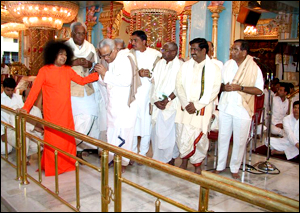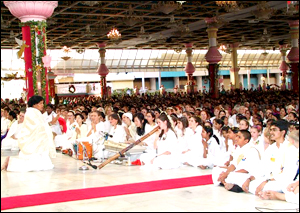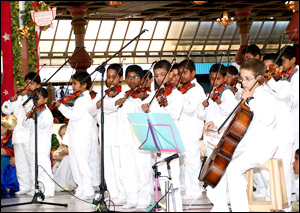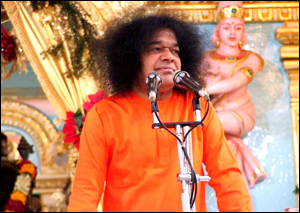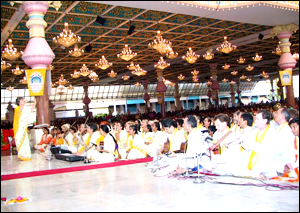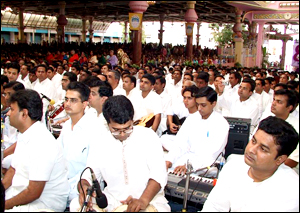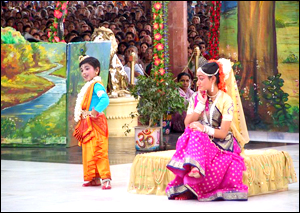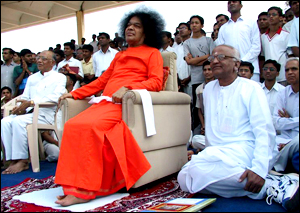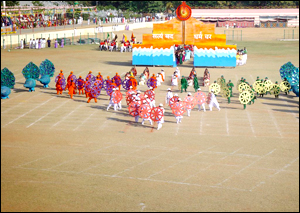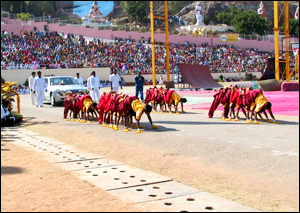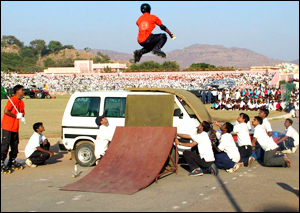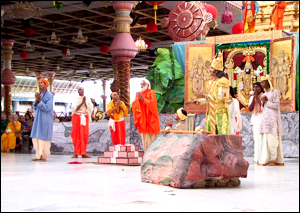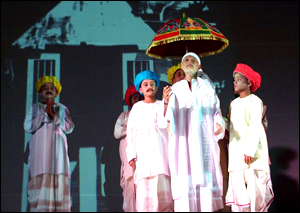 |
 |
 |
| Volume
3 - Issue 2, FEB 2005 |
DEC 14th, 2004: A POETS GATHERING IN SAI KULWANT HALL On December 14th, 12 noted poets from all over the state of Andhra Pradesh gathered in Prashanti Nilayam for a Kavi Sammelan - a gathering of poets for a reading of their poetry. This Sammelan, harking back to the rich old traditions of the princely states when such august personages would assemble in the royal court to sing the praises of the king, now gathered in Sai Durbar, under the auspices of the Potti Sriramulu Telugu University, to sing paeans of praise to the unending glory of the Lord. They recited one after the other, in mellifluous tones, in creative and enchanting Telugu poetic expressions, their unbridled feelings of love towards Him. While one sang about the glory and grandeur of the Avatar, another poet using the Telugu grammatical metre, sang in English about the intimacy of Sai. Yet another described Swami as two-eyed Shiva and four limbed Vishnu while another plaintively opined that he intentionally trod on the wrong path just to ensure that God descends in human form to correct him. On the whole the entire evening was a gentle cascade, an outpouring of words, feelings and emotions that enthralled every heart and exposed all to the expressive beauty of the Telugu language. To bring the evening to a close, Swami requested a student to address the gathering. This student expressed his gratitude to Swami for blessing these poets with an opportunity which even the renowned Telugu poet Pothana could not obtain. Swami finally honoured all the poets by individually draping an angavastram on their shoulders and then posing for group photographs with them. |
DEC 25th: CHRISTMAS DAY PROGRAMMES THE MORNING PROGRAMME - THE INSTITUTE BAND, THE PRIMARY SCHOOL ORCHESTRA, AND CHRISTMAS CAROLS BY THE STUDENT BODY Christmas Day dawned bright and joy was writ large on everyone's face. In front of the dais, across the railings, were idols of Joseph and Mother Mary in the Manger, watching with awe their Child and our Saviour! On the other side were the three Wise Men bringing presents to the Divine Child. The few lights that were on in the Mandir spread a warm glow all around. The Nagarsankirtan group singing "Silent Night Holy Night" - added to the serenity of the surroundings.
The Institute Band with 33 musicians opened the morning's celebrations with a programme of 6 tunes. The grand "O Come Little Children", followed by the gentle "It came upon a Midnight Clear", and the medley of "Silent Night", "Sai You are More Precious than Silver", "Oh Come All Ye Faithful" came next. Following this there was a 300 year old composition called, "Trumpet Tune"; followed by "Sleigh Ride", and finally "Jingle Bells". Swami's Primary School Orchestra then stole everyone's hearts. The orchestra consisting of 18 violins and a cello first played "Oh Come All Ye Faithful". This was followed by a solo cello with the minuet from J.S. Bach 1st Cello Suite. A brand new piece composed specially for the group, "Sai Joy" was played next. For the finale they played "Jingle Bells" 9 times while 4 primary school Santas threw candy to the joyful devotees in Sai Kulwant Hall. The boys of the Sri Sathya Sai Higher Secondary School and the Sri Sathya Sai Institute of Higher Learning sang merry songs to seek the choicest blessings from their Lord. Beginning with the carol "Merry Christmas" to greet one and all on this auspicious day, they followed it up with a beautiful song "Let Your Glory Fall", conveying the pining of the devotees for the Almighty. The song highlighted the very existence of a devotee - to be thirsty, hungry and to live a life only in want of God's Grace. The next carol, "Said the Night Wind" described the joy of the creation on the arrival of its creator. Generally night is associated with Tamo guna and day with Sattva guna. But Christmas night is considered to be the holiest of all, for it is the night when Jesus arrived. The carol "O Holy Night" showcased the importance of a night which was holy and which had an impact on the lives of millions. And of course, Christmas is not Christmas without the entry of a plump jolly man clad in red and white. The High School Santa Claus made his entry into Sai Kulwant Hall to the strains of the song, "Fun on Christmas" and made it a fun time by distributing chocolates all around. The enchanting programme ended with the songs "Hallelujah to the Lord" and "Christmas Card" which conveyed the profound gratitude of one and all to the giver and sustainer of everything. THE AFTERNOON PROGRAMME - 3 GUEST SPEAKERS FOLLOWED BY THE DIVINE DISCOURSE In the afternoon, as soon as Swami came to the veranda, a new silver gray Toyota four seater car, a right hand drive vehicle with only two doors (one on either side), was brought and parked in front of the veranda. Everyone's curiosity was whetted. Prof. Anil Kumar announced that the car had arrived from Japan this morning and that the front seat of the car was specially designed for Swami to get in and out of the car effortlessly. In this new car, the front seat next to the driver was motorised and will turn 90 degrees and come out automatically out of the door at the press of a button. The seat can then be lowered by the controls on the seat itself. Again, the seat can be taken back in and docked to its original position at the turn of a switch. The features of the car were then demonstrated to the crowd to the delight of all. Christmas afternoon featured three guest speakers followed by the Divine Discourse. The first speaker was Mrs. Rita Bruce (USA). Rita Bruce is the author of four books named: Vision of Sai I & II, Sathya Sai Parenting and Love of Conscience. Rita dedicated her talk to the Blessed Virgin Mary and Mother Easwaramma. She asked what we were doing as Sai parents to mould the character of children? Calling women as pillars of society she opined that women need to play a more leading role as agents of transformation. The
second speaker was Dr. K.K. Mistry from India. Hailing from Mumbai,
Dr. Mistry has been intimately connected with Dharmakshetra and is
instrumental in organising all the social service projects there like
medical camps and so on. Dr Mistry talked about his long association
with Swami and related movingly how Swami had cured him of an incurable
golf-ball sized tumour in the passage connecting his nose to his throat.
Swami gave His Divine Discourse next. At the very outset, He explained the mystery behind the new car. As He said, "A small boy and his sister were studying in our Primary School 20 years back. Their parents were so full of gratitude that Swami had given their children a seat in our School. It is out of this gratitude that they have offered this car to Me. The children were very intelligent. They have done their MBA and even received a gold medal. It is they who have sent this car as an expression of their gratitude to Swami". Stressing on the efficacy of prayer, Swami said, "Pray to God silently, without any desires, with Love. Everything will be added onto you. With Love any task can be fulfilled. Some say that they have been praying so hard but still they are not successful. Here the mistake lies in your prayer and not in the power of God. One must not pray to God in anticipation of any gifts. Pray to God for Him. God will supply all that we need. He knows what, where and when to give and to whom. Even if we do not make any effort, He will surely give us what we need. To desire and then get frustrated when the desire is not fulfilled is not the quality of a devotee". Bhagavan concluded His Discourse with the Bhajan, "Prema Mudita Mana Se Kaho". (For a full text of the Discourse visit the Sri Sathya Sai Central Trust site www.srisathyasai.org.in). Bhagavan
then blessed the devotees by sitting in the chair of the new hi-tech
car that was projecting out. In a few seconds the chair was lifted
and positioned into the car even while Swami was smiling and blessing
everyone. He then gave everyone a last Darshan by driving slowly around
the hall before disappearing into the dim evening light of Poornachandra!
What a glorious Christmas. We pray to Sai that the Christ consciousness
of this magical Christmas afternoon live with us and elevate us for
the rest of our lives. |
JANUARY 1st, 2005 - NEW YEAR'S DAY THE MORNING PROGRAMME - PERFORMANCES BY A NATIONAL CHOIR AND A WORLD CHOIR AND BHAJANS BY THE SOUTHERN CALIFORNIA BHAJAN GROUP With the recent tsunami on the day after Christmas that resulted in the loss of tens of thousands of lives in the coastal regions of many countries in South East Asia a solemn and sombre mood engulfed the Ashram. Thousands of devotees assembled in Sai Kulwant Hall on New Year Day, with hope and prayer in their hearts, seeking the soothing balm of the Lord's Feet and His tender comforting words and Blissful Divine Presence. The
Mandir wore a festive look with coloured banners with the words "80
Years of Love in Action", seen hanging from every pillar as well
as on the first floor of the veranda. Swami in His immense mercy had
acceded to the prayers of the SSSIHL alumni to decorate the Mandir
and they had done a magnificent job. An abundance of flowers added
colour and fragrance to the Mandir. An arch of 3 types of flowers
- pink lotus, yellow-hued sunflowers and red roses adorned the area
in front of Lord Ganesha in the veranda. A stream of pink roses and
white orchids interlaced with green leaves lined the entire façade
and also ran down the entire height of the elevation. Bouquets of
bright yellow roses also adorned all the niches and corners of the
brass banisters surrounding the steps. The programme began with a talk by Sri Indulal Shah, former Chairman, World Council, Sri Sathya Sai Seva Organisations and currently International Advisor of the Organisation and Member of the Sri Sathya Sai Central Trust. In his talk Sri Indulal Shah said that the devotees should be what Hanuman was to Lord Rama and the Gopikas to Lord Krishna. The lives of the devotees should be an ideal to carry the message of Sai. The morning's programme consisting of the offering of a musical programme to Him by a National and a World Choir was labelled as "Sri Sathya Sai, Our Divine Destiny". This theme set the motif with which all the men and women welcomed the New Year by singing praises of the Lord and expressing our devotion and love for Him. The National Choir consisting of about 98 men and 94 women drawn from 19 states of India was organised by Mr. Nimish Pandya and conducted by Mr. Girish Atve. They sang about 6 songs including "Soham Sai Om", "Sai Sathyam, Sai Nityam", "Vishwa Ke Adhar Hai Sai", "Jai Jai Sai Ram", and "Prema Rupa Sai Deva, Prema Data Sai Deva".
The World Choir co-ordinated by Mr. John Behner, had 53 men and 96 women from 42 countries, and sang about 8 songs for Swami. The songs included "Now is the time to celebrate the presence of Our Lord, Embodiment of Love", "At Your Feet we fall dear Lord", "Teu Nome e Sathya, Bendito Seja, Eterno Sai", "Baba Father let me be yours and yours alone", "Yakanaka! Be one in the Spirit", "Sing for joy and bring our praises to the King", "Om Sai Baba, Eighty years with us on planet earth" and finally "Celebrate Swami, celebrate, celebrate on this Holy Day". As an unexpected bonus, at the conclusion of the World Choir, a group of young men and women from Southern California were then escorted into the front and squeezed into the narrow area between the veranda steps and the seated National and World Choirs. They immediately launched into singing Bhajans, singing not only the perennial favourites like "Allah O Akbar" but also some English Bhajans like "We're never far from the Avatar’s Eyes", "Chant the Name of God, Sing the Glory of the Lord", "More Love, More Power, More of You in My Life", and "Shalom Hallelujah". This brought to a close the morning programme to welcome the New Year. The morning's rousing and soulful music had filled everyone with ecstasy, as only singing the praises of the Lord can. Truly it is said - 'Happiness is only in Union with God'.
New Year’s Day evening brought the alumni of the Sri Sathya Sai Institute of Higher Learning flocking to Sai Kulwant Hall to offer their tributes to Him at the dawn of another New Year. These old students of the Institute who had decorated the Mandir for the day, now offered a musical programme to Him and serenaded Him to welcome the New Year. The students sang about 16 songs for the Lord, in Telugu and Hindi, with appropriate commentary in both Telugu and English to introduce each song. Almost all the songs reflected the sentiment of Swami's deep love for all His students and their reciprocal love and attachment for Him. Starting with "Vidyaku Vinayame", a prayer to Lord Ganesha, the students sang numerous songs like "Saieeswara", "Mere Sai", "Jab Bhee Tum", "Naa Yee Tera", "Raghuvara", "Sirf Ek Hi Kam", "Tum Bin", "Sarwavatara", "Lee Lee Tera Nam" and concluded with the group song, "Kaise Batayen". Throughout, Swami was immersed in the songs, while all of us were lost in the bliss of His Heavenly smile and the gentle beats of His Divine Hands keeping time with the music.
Following the song programme presented by the old students, Swami next called the leader of the brass band of the Sri Sathya Sai Institute of Higher Learning and blessed that the band may commence its New Year's programme. The 30 members of the band performed a lively programme of 6 pieces (which included two Bhajans) - "Gajavadana", "Final Countdown", "Hungarian Dance", "La Bamba", "Shankara, Shankara", and "Bread Fan". Swami twice requested more music and the band happily complied, responding with "Air", followed by "Brass Explosion". Swami blessed the band leader by calling him to the dais and materializing a beautiful gold bracelet for him. Swami then blessed Mr. Ajit Popat from U.K. to address the gathering. He spoke about the inner significance of the word "HAPPY" in the term "Happy New Year" as explained to him by Bhagavan: H - Holy, A - Awareness, P - Patience, P - Purity, Y - Yogi. He said that only when we put this meaning of the word HAPPY and Swami's teachings into practice can we really call it a Happy New Year. Thus ended a beautiful day that provided respite from recent events and the hope that with the Lord's Grace, things will be much better in the New Year. |
JAN 6th: KRISHNAM VANDE JAGADGURUM - A DRAMA BY THE SRI SATHYA SAI VIDYA VIHAR, VISAKHAPATNAM Sri Sathya Sai Vidya Vihar, Visakhapatnam, a school with 1,600 students on its rolls, had the unique privilege of staging a musical dance ballet titled "Krishnam Vande Jagadgurum", in the Divine presence on Jan 6th, on the occasion of the completion of 20 years of excellence of the school. This musical ballet, inspired by Bhagavan's Bhagavatha Vahini, depicts how loving Krishna reveals the secret of His incarnation to His mother Yashoda and the Gopikas, while enchanting them with His mischievous Leelas. The ballet opens with Yashoda searching for her son, and on finding Him decorates His body lovingly. It also shows the Gopikas complaining to the Divine mother that her son has become a butter thief. Unable to believe this as abundant butter is available in their own household, Yashoda is however entreated by the Gopikas to enquire further into the matter. While cradling Krishna lovingly in her lap and singing Him a lullaby, Yashoda sweetly asks Krishna if the Gopikas were right. At first feigning sleep, then ignorance and also mock anger Krishna teases Yashoda, before finally confessing mischievously that He really is a butter thief! Denying any fault on His part, Krishna asserts that it is His right to do so as He has protected the Gokulam by punishing the snake Kaleeya, by killing demons and lifting the Goverdhana Hill to protect the village from Indira's downpour. He further proclaims that in Kaliyuga He will incarnate as Sri Sathya Sai. The ballet concludes with Yashoda and the Gopikas realizing Krishna as the Lord of the Universe and singing and dancing His Glory. The baby Krishna stole everyone's hearts and the young girl who acted the part of Yashoda really brought out her maternal Bhava for Krishna and brought tears in everyone's eyes. Swami at the end manifested a chain for the young Krishna and also posed for group pictures with all the young actors to show His appreciation of their fine effort. |
The Annual Sports and Cultural Meet of the Sri Sathya Sai Educational Institutions is a much awaited event. January 11th of every year thus marks a sort of homecoming as the students and the staff of all the 3 campuses of the Sri Sathya Sai Educational Institutions (at Brindavan, Anantapur and Puttaparthi) as well as the Primary and the High Schools assemble for the big day in Sai Vidya Giri Stadium. The intramural sports part of this annual event is actually over much before this big day. The events start in early December and the students in each campus are broken up into 4 houses (Sathya, Dharma, Shanti and Prema). While sports everywhere is a matter of winning at all costs, the sports meet here emphasizes more on co-operation rather than competition, the spirit of participation rather than the mechanics of prize winning. The boys in these 4 houses then "vie against each other" in games like cricket, volleyball tennis and so on. There are also talent competitions like singing and debating contests, essay writing and other literary activities. It is all in fun - in a spirit of camaraderie, fellowship and brotherhood. Sometime in the middle of December however, the students become a little more determined. They now think of the cultural and daredevil events to perform on the Big Day in front of the sweet Lord. Not only events have be creatively dreamt up but sets organised, uniforms and clothing arranged, props to be made and so on. And of course committees are formed with each boy being assigned a specific duty. There are also many sundry things to do like making torches to carry the flame on this day, offering a selection of different mascots so Swami could pick one, and so on. After the events are decided on, the students now start the arduous task of practising again and again till perfection is reached, and the new skills learnt rapidly are internalised till they become second nature. While the initial practise sessions are done in their respective campuses, in the early part of January (this year on January 8th) all the students assemble in Puttaparthi to practise at the Stadium and finalise things like positioning and so on. A ground sharing arrangement is in force and different campuses use the ground as per the schedule throughout the day. Thus an air of excitement pervades the town and it is not uncommon to hear the brass band practise as late as 10:30 p.m!
As the day approaches, Swami also encourages the students and inspires them by occasionally dropping in on the field during the practice sessions. Sometimes He silently watches the practice from His car itself, but sometimes He alights and sits in the chair specially put out for Him. Then all the students who are not scheduled for practice gather around Him, like one big happy family, while He watches the other students go through their routines. Swami gently makes suggestions but for the most part shows His appreciation by His silent smiles and happy looks at all the eager faces around Him. This year on January 9th, the benevolent Lord also had clothing material distributed to all the students as a symbol and token of His love for them. Finally the Big Day arrives! The events start early. Swami enters the Stadium around 7:30 a.m., in the open car where His seat is in the front and the driver's seat is behind Him. A gasp goes up as people realize that He has come in His white robe as a special blessing. Swami is received at the entrance by the Brindavan boys on horses, and the Puttaparthi and Anantapur marching bands. After entering the stadium Swami's car goes through a canopy of flags formed by the captains of the different events. The procession then goes all the way up to Shanti Vedika where Swami alights and climbs the stage. He immediately lights the lamp to signify the start of the meet and the ceremonial march past begins. All the students of the Educational Institutions starting with the Primary School, followed by the Anantapur campus and the Anantapur Junior College march past saluting the dais. The girls are then followed by all the boys of the Puttaparthi High School, the students of the Brindavan campus, and lastly the host - the Prashanti Nilayam campus. The singing troupe and the athletes bring up the rear. All the students look smart in well co-ordinated clothes and decked out in their house colours. Swami then hoists the flag after which the oath taking ceremony takes place. The Institute boys then bring the torch to be blessed by Swami and the torch is carried by runners up to the bottom of the hill from where this year's mascot (Garuda or the eagle) made out of steel wiring and paper and painted in gold, is pulled up to the top of the hill carrying the torch. When the torch reaches the top of the hill, it lights the big urn and the lighting of the fire signifies the start of the meet. Swami then releases pigeons and balloons also. After the formal opening ceremony, we had the campus presentations. The morning belonged to the Brindavan and the Anantapur campus. The Anantapur campus opened their programme, "The Path of Dharma is the Path of Sai" with a short welcome dance. This was followed by an exhibition of martial arts (stick fighting, fencing, sword-fighting) with the theme that when you protect others you protect yourself and when you protect yourself you protect others. The girls then gave an exhibition of stunts on motor bikes, including jumping through hoops of fire and clearing 16 of their peers lying on the ground after taking off on a ramp. Then followed a cultural item with a peacock dance and for the finale there was a song and dance item that had a patriotic theme to exhort everyone to serve the motherland.
After the Anantapur Campus came the children from the Deenajanodarana Pathakamu, from Swami's orphanage, who stopped in front of the dais on a decorated float performing magic tricks to illustrate that life is an illusion. The last item of the morning programme was the display by the Brindavan campus entitled – ‘A Journey from I to We and We to He!’ The highlight of their presentation was a breathtaking display of acrobatics, entitled ‘Celestial Rhythms’, on a metal grid suspended in the air about 80 feet high lifted by a crane. They made numerous patterns in the air in their coordinated and contrasting uniforms with only the background of the blue sky. Starting with the figure 80 to signify the 80th year of advent, they formed numerous attractive diamond shapes and other symmetric patterns including the word SAI. While the Celestial Rhythms were air-bound, their more down to earth brothers, calling themselves Creative Expressions, displayed various formations on independent hollow decorated metal cubes arranged in many symmetric patterns. With their theme of 'bend the body, mend the senses, end the mind', they really bent their body around these arrangements of the hollow cubes to give a visually pleasing performance. Simultaneously on either side of the Creative Expressions display a group of about 100 students performed exercises using coloured wooden planks to create different patterns and effects as well as an item using it as a seesaw and as a diving board for a student to dive off from into the hands of his brothers. This brought the morning's programme to a close.
The afternoon saw the primary boys and girls and the girls from the High School take centre stage. The tiny tots performing in their costumes in the hot afternoon sun managed to make everyone else forget their own discomfort. Their presentation lasting about 1 hour was a delectable mix of songs and dances, all done with gusto and bubbling enthusiasm. Elaborate costumes and pleasing props enabled them to put on such visual treats like a fan dance where they opened the fans in many different ways to display different colours and designs; a balloon dance with peacocks, a sunflower dance and other myriad representations. Veritably the whole school participates and the resulting blend is a fast moving and thrilling display where small tots would pop up and then disappear in a myriad of colours and artistic symmetry. The tiny boys in the primary school also did a lot of acrobatic tricks in front of the dais. Earlier these tiny acrobats had welcomed Swami to the stadium amidst loud applause from the crowd, in their imitation of the 'centipede walk' by curling up their legs on the shoulders of the boy behind while all of them are on all fours.
Finally the host campus, the Prashanti Nilayam boys, took centre stage to cap a fine day of programmes with their display. The opening item was a Shiva Tandava dance done against the background of a huge Nataraja idol fabricated by the boys themselves. Lord Shiva is the epitome of the dancing art and the boys outdid themselves in dancing in front of Lord Shiva Himself. The sight of the 2 boys dressed as Lord Shiva and Parvathi dancing on an elevated platform while about 30-40 boys danced in synchronous fashion on the ground, in various costumes as sages and ordinary village folk, was delectable eye candy for the crowd. In quick succession other items followed. First was Caribining - where the boys came gliding down ropes tied from a high point on the hillside to the ground; the trampoline stunts including dunking the basketball after taking off from the trampoline and performing a somersault; the Moving Marvels wherein six pairs of boys did tricks on 6 large rimmed moving wheels; a Gun Drill focussing on perfect synchronization as the boys (dressed in red and dark blue) performed various movements with their guns in rapid succession to give a pleasing wave effect. 'Terrestrial Champions' a display of stick exercises combining speed, dexterity and synchronisation was next, ending with a display of a mock stick fight in the traditional Indian form of martial art. Roller Blading was next, wherein stunts on roller blades were done on a U-shaped ramp specially fabricated for the event using stainless steel plates.
The finale for this event where the boy jumps off a ramp and clears a Maruti van drew applause from one and all. In Waves in the Valley a myriad of boys from the High School, made various wave formations by holding onto the shoulders of the boys on either side of him. The last item for the afternoon and this year’s Sports meet was a "reverse bungee jumping", by the Brindavan campus, where a student on the ground is tied to a rope stretched from the end of a crane and is catapulted about 100-120 feet in the air. These bungee boys then each came up to Swami and offered a bouquet to Him and received His blessings. As a grand finale, all the Prashanti Nilayam boys who performed in the afternoon, gathered in a semicircle in front of the stage to offer their respects to Bhagavan. The Sports Meet served as a grand precursor to the celebrations of the 80th year of the advent of our Lord. It helped put the tragic events at the end of last year behind us and to look forward to a grand sequence of events to hail His Glory for the rest of this epoch-making year. |
105 Bala Vikas children from Visakhapatnam, East Godavari, West Godavari, Krishna and Guntur districts of Andhra Pradesh participated in this programme to celebrate 'Makara Sankranthi', a harvest festival, in the presence of Bhagavan. The ballet, explaining the different practises in the celebration of Makara Sankranthi, begins with an invocation to Parthi Ganesha describing Him as a Prema Avatara, and that the real Sankranthi is one which sows the seeds of selfless service and sacrifice. This was followed by an invitation to 'Sankranthi Lakshmi', who will bring prosperity when she steps into a house. They then sang a song called ‘Melu Kolup’ depicting Bhagavan as the Universal Lord. 'Haridasulu' a folk art is enacted to spread the practice of Namasmarana.
The first day of Sankranthi is Bhogi and on this day the children receive the blessings of elders in the form of ‘Bhogipalli’, the title of the next song. This song depicts Swami as a sweet child and offers Bhogipalli to Him. Jamgama Devara comes every morning singing the name of Siva. This song thus depicts the Siva Tandava dance. 'Bommalakoluvu', is a beautiful tradition where people arrange the decorated deities of the different Gods on the altar and then invite their kith and kin, thus developing bonds of love among people. 'Buda Bukkalu' is a folk art where the artists go house by house to wish prosperity and good fortune to the inmates. On the day of 'Kanuma' people worship cows and bulls to bring them prosperity. In the finale the small children declare that they are the children of Sai and that His word is the Veda to them. They promise to tread the path of Sathya, Dharma, Shanti, and Prema and pledge that they would treat their parents and teachers as God, and everyone as their own kith and kin and that they would live every minute on the Sai path. |
JAN 13th: 'TAALLAPAAKA ANNAMAACHAARYA' A DRAMA BY THE BRINDAVAN CAMPUS OF THE SSSIHL The evening of the 13th saw an electrifying performance displayed by the students of the Brindavan when they depicted the life story of a devotee poet called Annamacharya. This drama involved about 100 students including the dancers, actors, set boys and the music boys. Annamacharya, popularly known as Annamaya, was born in the village of Tallapaka in Andhra and was the only son of his parents. He at first decided that only beautiful nature was worthy of worship. But the Lord willed that Annamaya's life be exemplary to all and in His inimitable way directed the drama of Annamaya's life. He sent the celestial sage Narada who gave Annamacharya a vision of the Lord, and thus Annamacharya was totally captivated. Narada also gave a tambura to him and thus was born the poet saint. Annamacharya then poured out his love for God in the form of songs - the best way to win the heart of the Lord. As a Sankirtanacharya, he composed 32,000 kirtanas in praise of his beloved Lord Venkateshwara.
The boys brought out his devotion in an exemplary fashion. Elaborately designed sets, including the gold gopuram of a temple (fabricated and made by the boys themselves out of papier mache) lent a very authentic air to the drama. One scene in particular stands out, when Annamacharya came to the door of the temple but found them closed for the day and is chased away by the priest. The despondent Annamacharya plaintively cries out in anguish that he does not want to leave without the Darshan of his beloved Lord Venkateshwara. The doors of the temple then immediately swing open to grant this pure devotee his heart's desire, revealing Lord Venkateshwara in all His splendour (the deity also being lovingly made by the students themselves). King Saluva, impressed by the divine charm of Annamaya's music, offers him the position of the royal court singer, which Annamaya politely refuses as he only wants to sing for the Lord. This prompts the king to become his disciple. Years roll by and Annamacharya's prolific compositions inspire spiritual aspirants from all walks of life. In the next scene some low caste people complain to Annamacharya that they are not permitted to pray to the one God, the God of all, in the temple premises. Then Annamacharya himself leads them into the temple, which angers the temple priests and they throw all of Annamacharya's written compositions, his whole life's work, into the fire. But Lord Vishnu from Vaikunta (fittingly standing up high on the top of the temple gopuram) comes to Annamaya's protection and the verses are saved. The disciple king pleads and gets his permission to etch Annamacharya's verses on copper plates and they are thus saved for posterity. At the age of 95, Annamacharya decides that it is time for him to leave his body. In a sublimely emotional final scene the Lord tries to persuade Annamacharya to continue singing for him by promising him eternal youth and immortality. Eventually the Lord yields to Annamacharya's request for deliverance but asks him to sing a final song for Him. Annamaya then sings one final song, bringing tears to everyone's eyes, before merging with the Lord. Such was Annamacharya's love for God that for all time, his name has become synonymous with that of the Lord Venkateshwara. |
JAN 14th: VALEDICTORY FUNCTION FOR THE ANNUAL SPORTS MEET AND A PRIMARY SCHOOL DRAMA ENTITLED 'SAI BHAGAVATHAM' THE MORNING PROGRAMME - PRIZE DISTRIBUTION AND DIVINE DISCOURSE ON THE OCCASION OF PONGAL / SANKRANTHI The morning session formally brought the Sports and Cultural Meet to an end. The Sai Kulwant Hall was aesthetically decorated for the occasion with a temple and a mountain scene printed on large screens forming the backdrop, against which the trophies and cups were arranged for distribution. Swami arrived in Sai Kulwant Hall escorted by the Anantapur and Puttaparthi marching bands and the captains holding up a canopy of flags for Him to pass through. He was received on the dais by the physical instructors of the Puttaparthi and Brindavan campuses, and then lighted the lamp to inaugurate the function. Sri Sanjay Sahni welcomed everyone. Swami then blessed the Vice-Chancellor Sri S.V. Giri to address the crowd.
Sri S.V. Giri talked about his experience with the Sports meet and also mentioned the enormous love and concern that Swami expressed for the students’ welfare at every stage of the Sports Meet. Swami then blessed 2 students (from the Anantapur and the Puttaparthi campus) to talk to the audience. They also talked about Swami's enormous love and guidance at all stages of the Sports Meet. The Anantapur girl mentioned that during one of the motorbike stunts the cable wire snapped but the motor cycle ran normally till the event was over (after which it stopped). The other speaker from the Puttaparthi campus talked about the confidence that Swami generates in all the students to do the stunts in spite of spills and accidents and said that life is worth only if it is lived for Him. After this Swami gave His Divine Discourse as January 14th is also Pongal or Sankranthi, a harvest festival celebrated in almost all parts of the country. Swami in His Discourse alluded to the word Sankranthi and said that kranthi means change. Hence He asked everyone to change and become happy and blissful. True happiness He said is only in union with God and cannot be found in the temporary and fleeting pleasures of the world. Everlasting bliss emanates from within and He exhorted everyone to find the God within and claim their legacy of bliss.
In the afternoon, the primary school students put up a drama entitled Sai Bhagavatham. The little children from the age of 5 upwards put on an enchanting show. With a well edited video projected on a giant screen providing a fitting and appropriate backdrop for the story line, the small students recounted His Story in a touching fashion in the foreground of the Poornachandra stage.
Starting with the story of Creation, they brought out how Swami created the world at His pleasure. But over time the world degenerates and everything in the Universe follows their ordained rhythm except for humans. This prompts Shiva of the trinity (of Brahma, Shiva and Vishnu) to declare that He will incarnate in the world to restore Dharma into their pre-eminent place. The scene then moves to the Ashram of Sage Bhardwaja who decides to go to Kailash to invite Siva and Parvathi to his Yagna and gets from them a boon that He will be born in their lineage. The drama also depicts the prediction of Swami's coming in the other religions like in Christianity where Jesus declares that "I am the Son of God and I have come to prepare the way for His coming". Under the backdrop of a scene from Mecca's holiest shrine, the teachings of Islam which foretell the incarnation of Swami along with a description of His physical features, was portrayed (including the description of the mole on the cheek, the wearing of the flaming red robe and broad forehead). The story progresses to show the first of Lord Shiva's triple incarnations as Shirdi Sai Baba. In a touching scene, Shirdi Baba gives some money to Sharda Devi and says that He will ask for it again in His next incarnation. This acts as a precursor to bring about the story of our own beloved Swami. We are then shown Kondama Raju talking to his Gurdeva about the incarnation of the Kalki Avatar. The story progresses quite fast then and shows Mother Easwaramma telling grandfather Kondama Raju about the blue light entering her while she was drawing water from the village well. The story then quickly moves through some of the prominent incidents from Sathya's boyhood, including the declaration of His Avatarhood. Moving on the play depicts the sorry plight of the poor, who are unable to either give a hefty donation for school admission, or have the ability to pay for expensive healthcare, in obtaining school admissions and healthcare. The play also depicts how Swami's selfless service and love (in the form of the free hospitals and free educational systems) transforms these very same people who had oppressed the poor and they in turn vow to spend their lives in the service of others.
|
| Optimized for Netscape and Firefox. Best viewed in Internet Explorer - 1024 x 768 resolution. |
